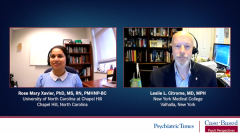
Prevention and Early Detection of Tardive Dyskinesia
In this custom video series, Rose Mary Xavier, PhD, MS, RN, PMHNP-BC, shares advice that can be helpful to community providers who manage children and adult patients prescribed antipsychotic therapy about screening for involuntary body movements and early signs of tardive dyskinesia.
Episodes in this series

Leslie L. Citrome, MD, MPH: Dr Xavier, any advice for community providers?
Rose Mary Xavier, PhD, MS, RN, PMHNP-BC: Definitely. The key thing to keep in mind is any type of dopamine-blocking agent can cause tardive dyskinesia [TD] or any type of movement disorder. Regardless of if they’re on an antipsychotic or something like an antiemetic that can increase the risk for these movements, visual assessment for movement disorders is essential when they’re prescribed any agent that increases the risk for tardive dyskinesia movements. Specifically, recognize that we’re using atypical antipsychotic medications to treat something more than just primary psychotic disorders, including mood disorders as an adjunct for a major depressive disorder. This makes it essential to monitor so visual assessment.
I stress the importance of monitoring the patient at every visit just to check in with them, to see if they’re developing it. Early intervention is critical. Even though we talk about tardive dyskinesia in terms of years for the onset, from studies we know that it can be answered, can be from several weeks to years. If it’s identified early, then you can either stop the agent or try something different. But the longer the patient has stayed on antipsychotic medication, and TD has developed several years later, then TD may not be irreversible. The impact on the patient is huge. That’s the most critically critical thing that we need to keep in mind.
Think of going back to your teenage years when you had a zit or an acne and how it affected you. Now you’re living with the condition that’s supposed to make your illness better, but you have an adverse effect. That’s not a small thing. To community providers, don’t think that tardive dyskinesia has vanished or isn’t prevalent anymore. With first-generation antipsychotic medications, we knew it was 30%. For someone who was prescribed first-generation antipsychotic medication and who was on the second generation, the risk was still 21%, but someone who has never been on a first-generation medication, the risk is 7%. Lastly, for children, just with the prescriptions, the antipsychotic prescriptions that we give for children to manage behavioral disorders with autism, or behavioral disorders with intellectual disability, the off-label use is really important. Some studies have been done in children. We know that 9% of children who are prescribed antipsychotic medications have these moments. We don’t talk about those things, but they’re really important. The assessment, the monitoring, the follow-up, the conversation with our patients and our family—that’s the most important thing.
Leslie L. Citrome, MD, MPH: Thank you. We have to assume that TD exists in our practice. If we look for it, we’ll find it. You’re quite right. We use antipsychotics for a wide range of disorders. They are FDA approved for bipolar disorder and as adjunctive use and major depressive disorder, very common usages. One of the sad things about tardive dyskinesia is that someone may develop it after only a few months of being on a second-generation antipsychotic, and you stop that second-generation antipsychotic. Let’s say they have major depressive disorder, and you can use something else. Well, that TD may not go away. This is 1 of the things about TD that’s so maddening. It won’t go away by itself, and we have to treat it. Thank you for your comments regarding advice to community providers. That’s very helpful.
I want to thank you, Dr Xavier, for this conversation, and I want to thank the audience for their attention. Thank you all for watching The Psychiatric Times®’s Case Based Psych Perspectives program. This has been an excellent discussion, and we hope you found the information valuable to your clinical practice.
Transcript edited for clarity.
Newsletter
Receive trusted psychiatric news, expert analysis, and clinical insights — subscribe today to support your practice and your patients.

















